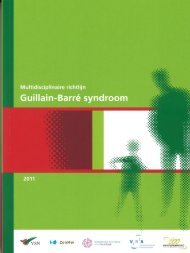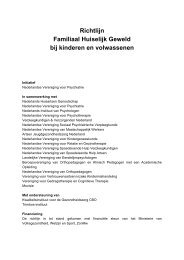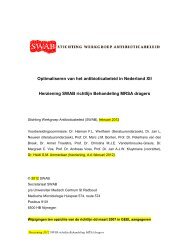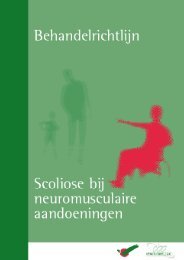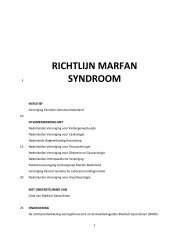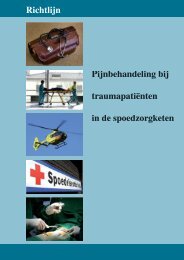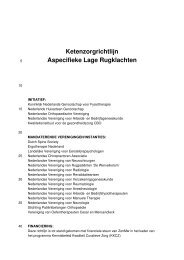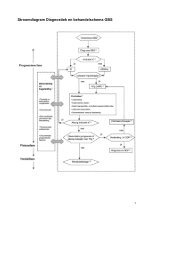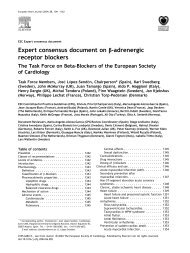Richtlijn: Otitis Externa - Kwaliteitskoepel
Richtlijn: Otitis Externa - Kwaliteitskoepel
Richtlijn: Otitis Externa - Kwaliteitskoepel
You also want an ePaper? Increase the reach of your titles
YUMPU automatically turns print PDFs into web optimized ePapers that Google loves.
Acute <strong>Otitis</strong> <strong>Externa</strong>, Differentiaal diagnose<br />
Uitgangsvraag 1a<br />
Hoe wordt de diagnose acute otitis externa gesteld?<br />
Onderbouwing<br />
A diagnosis of diffuse AOE requires rapid onset with signs and symptoms of ear canal inflammation.<br />
Symptoms of AOE include otalgia (70%), itching (60%), or fullness (22%), with or without hearing loss<br />
(32%) or ear canal pain on chewing. A hallmark sign of diffuse AOE is tenderness of the tragus (when<br />
pushed), pinna (when pulled up and back), or both. The tenderness is often intense and<br />
disproportionate to what might be expected based on visual inspection. Otoscopy will reveal diffuse<br />
ear canal edema, erythema, or both, either with or without otorrhea or material in the ear canal.<br />
Regional lymphadenitis or cellulitis of the pinna and adjacent skin may be present in some patients<br />
(Agius 1992, Lucente 1995).<br />
Anything that disrupts the epithelium of the ear canal can permit invasion by bacteria that cause<br />
diffuse AOE. Common predisposing factors for AOE (Hirsch 1992) are humidity or prolonged<br />
exposure to water, dermatologic conditions (eczema, seborrhea, psoriasis, folliculitis), anatomic<br />
abnormalities (narrow canal, exostoses), trauma or external devices (wax removal, insertion of<br />
earplugs, use of hearing aids), and otorrhea caused by middle-ear disease. AOE may also occur as a<br />
result of ear canal obstruction by impacted cerumen, a foreign object, or a dermoid or sebaceous<br />
cyst. Clinical history should identify predisposing factors and assess swimming behavior. Other causes<br />
of otalgia, otorrhea, and inflammation should be distinguished from diffuse AOE because<br />
management will differ. The most important differential diagnoses are summed up below.<br />
Acute <strong>Otitis</strong> Media<br />
AOE can mimic the appearance of acute otitis media (AOM) because of erythema that involve the<br />
tympanic membrane. Distinguishing AOE from AOM is important because the latter may require<br />
systemic antimicrobials (Lieberthal 2004).<br />
Pneumatic otoscopy will demonstrate good tympanic membrane mobility with AOE but will show<br />
absent or limited mobility with AOM and associated middle-ear effusion. Similarly, tympanometry<br />
will show a normal peaked curve (type A) with AOE, but a flat tracing (type B) with AOM. The validity<br />
of acoustic reflectometry with AOE is unknown.<br />
Contact dermatitis<br />
Contact dermatitis of the ear canal is an allergic reaction to antigens such as metals (nickel, silver),<br />
chemicals (cosmetics, soaps, detergents, shampoo, hairspray), plastics, rubber, leather, or drugs.<br />
Fragrance additives may also cause similar reactions. Finally, contact sensitivity may be caused by<br />
silicone ear plugs or by hearing-aid molds that contain silicone or methyl-methacrylate. Nickel is the<br />
most common contact allergen, affecting around 10% of women with pierced ears (Peltonen 1981,<br />
Rudner 1973, Larsson-Styme 1985). Contact allergy also occurs in some patients who wear hearing<br />
aids as a reaction to the plastics and other chemicals used in hearing aid molds (Meding 1992,<br />
Cockerill 1987).<br />
13 <strong>Richtlijn</strong> <strong>Otitis</strong> <strong>Externa</strong> 2010<br />
Nederlandse Vereniging voor Keel-Neus-Oorheelkunde en Heelkunde van het Hoofd-Halsgebied




